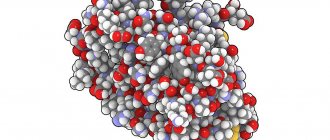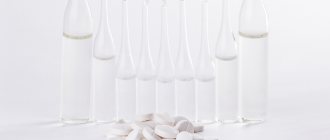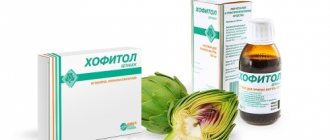The antiviral drug VIFERON is produced in the form of suppositories, as well as ointments and gels. It contains recombinant interferon alpha-2b, tocopherol acetate and ascorbic acid (vitamins E and C), and has antiviral and immunomodulatory properties. The drug prevents the multiplication of the virus in the human body and is used for the treatment and prevention of viral and other diseases. VIFERON is available in dosages of 150,000 IU, 500,000 IU, 1,000,000 IU and 3,000,000 IU.
- Instructions for use by adults Contraindications
- Side effect
The drug VIFERON is used for the treatment of acute respiratory viral infections (ARVI), including influenza and complications due to bacterial infection, as well as pneumonia. The drug is also used as part of complex therapy in the treatment of such common infections as chlamydia, trichomoniasis, candidiasis (popularly called thrush) and mycoplasmosis - diseases caused by mycobacteria - intracellular parasites. Mycoplasmas can be a component of the flora of the genital organs for quite a long time and not reveal their presence in any way. The development of symptoms characteristic of the disease occurs under unfavorable conditions for the body.
Also, the antiviral drug VIFERON is used in the treatment of cytomegalovirus infection (CMVI), a viral infection that is characterized by a chronic course and a variety of forms. The disease can occur either in a latent form or lead to a generalized form - the most severe form of the disease, which is fraught with the development of serious complications. Previously, it was believed that CMV was spread only through saliva, which is why it was called the “kissing disease.” But in fact, this virus can attack a person through contact and household contact, when using common hygiene items. Fetal damage may also occur in an infected pregnant woman.
Nosological classification (ICD-10)
- A41.9 Septicemia, unspecified
- A49.3 Mycoplasma infection, unspecified
- A59.0 Urogenital trichomoniasis
- A74.9 Chlamydial infection, unspecified
- B00.0 Herpetic eczema
- B00.1 Herpetic vesicular dermatitis
- B18 Chronic viral hepatitis
- B25.9 Cytomegalovirus disease, unspecified
- B34 Viral infection of unspecified localization
- B37.3 Candidiasis of the vulva and vagina (N77.1*)
- G03.9 Meningitis, unspecified
- J06 Acute upper respiratory tract infections of multiple and unspecified localization
- J11 Influenza, virus not identified
- J18 Pneumonia without specifying the pathogen
- N39.0 Urinary tract infection without established location
- N76 Other inflammatory diseases of the vagina and vulva
- O35.3 Fetal injury (suspected) due to maternal viral disease requiring maternal medical attention
- O35.8 Other fetal anomalies and lesions (suspected) requiring maternal medical attention
Viferon-3 1000000me n10 rectal suppositories
pharmachologic effect
A preparation of human recombinant interferon alpha-2b. It has antiviral, immunomodulatory and antiproliferative effects. Under the influence of interferon in the body, the activity of natural killer cells, T-helpers, cytotoxic T-lymphocytes, phagocytic activity, the intensity of differentiation of B-lymphocytes, and the expression of MHC type I and II antigens increases. The drug also directly inhibits the replication and transcription of viruses and chlamydia. Damage to cell membranes observed during the development of the infectious process is the reason for the decrease in the antiviral activity of interferon. Tocopherol acetate and ascorbic acid, which are part of the drug Viferon, are membrane-stabilizing components, antioxidants, in combination with which the antiviral activity of recombinant interferon alpha-2b increases 10-14 times. In addition, the immunomodulatory effect of interferon on T- and B-lymphocytes is enhanced, the content of immunoglobulin E is normalized, and there are no side effects (fever, fever, flu-like phenomena) that occur with parenteral administration of interferon preparations. It has been established that when Viferon is used for 2 years, antibodies that neutralize the antiviral activity of recombinant interferon alpha-2b are not formed. The use of the drug Viferon can significantly reduce course doses and duration of courses of treatment with antibiotics, hormones and cytostatics. Features of the administration of the dosage form ensure long-term circulation of interferon alpha-2b in the blood.
Pharmacokinetics
12 hours after rectal administration of Viferon, a decrease in the level of interferon in the blood serum is observed, which necessitates its repeated administration.
Indications
– as part of complex therapy of infectious and inflammatory diseases in newborns (including premature babies): ARVI, pneumonia (bacterial, viral, chlamydial), meningitis, sepsis, specific intrauterine infection (chlamydia, herpetic infections, cytomegalovirus infection, enterovirus infections , visceral candidiasis, mycoplasmosis); – as part of complex therapy for chronic viral hepatitis B, C, D in children, as well as in the treatment of chronic viral hepatitis with a pronounced degree of activity and liver cirrhosis using plasmapheresis and hemosorption; – in pregnant women with urogenital infection (chlamydia, genital herpes, cytomegalovirus infection, ureaplasmosis, trichomoniasis, gardnerellosis, human papillomavirus infection, bacterial vaginosis, recurrent vaginal candidiasis, mycoplasmosis) as an interferon-corrective agent; – treatment of herpetic lesions of the skin and mucous membranes (for ointment).
Dosage regimen
As part of complex therapy for infectious and inflammatory diseases in newborns (including premature babies)
suppositories containing 150 thousand IU of interferon alpha-2b are prescribed.
For newborns (including premature) children with a gestational age of more than 34 weeks,
the drug is prescribed 1 suppository 2 times a day with an interval of 12 hours.
Premature children with a gestational age of less than 34 weeks
- 1 suppository 3 times a day with an interval of 8 hours The course of treatment is 5 days.
Recommended number of courses of Viferon for various infectious and inflammatory diseases in newborns (including premature babies)
: ARVI - 1 course;
bacterial pneumonia - 1-2 courses, viral - 1 course, chlamydial - 1 course; sepsis - 2-3 courses; meningitis - 1-2 courses; herpetic infections - 2 courses; enterovirus infection - 1-2 courses; cytomegalovirus infection - 2-3 courses; mycoplasmosis - 2-3 courses. The break between courses is 5 days. According to clinical indications, therapy with Viferon can be continued. As part of complex therapy for chronic viral hepatitis B, C, D, children under 7 years of age
are prescribed suppositories containing 500 thousand IU or 1 million IU of interferon alpha-2b;
children over 7 years of age
are prescribed suppositories containing 1 million IU or 3 million IU of interferon alfa-2b depending on clinical parameters: 2 suppositories/day with an interval of 12 hours daily for 10 days;
then prescribe 2 suppositories/day with an interval of 12 hours 3 times a week every other day for 6-12 months. In case of chronic hepatitis of severe activity and liver cirrhosis, before plasmapheresis and/or hemosorption, 2 suppositories per day are prescribed with an interval of 12 hours daily for 14 days. Children under 7 years of age
are prescribed suppositories containing 150 thousand IU;
children over 7 years of age
are prescribed suppositories containing 500 thousand IU of interferon alpha-2b.
As part of complex therapy for pregnant women with urogenital infection during pregnancy from 28 to 34 weeks,
suppositories containing 150 thousand IU of interferon alpha-2b are prescribed, 2 suppositories/day with an interval of 12 hours every other day.
The course of treatment is 10 suppositories. From 35 weeks before delivery,
suppositories containing 500 thousand IU of interferon alpha-2b are prescribed, 2 suppositories/day with an interval of 12 hours daily. The course of treatment is 5 days. A total of 7 courses are prescribed over 12 weeks. The break between courses is 7 days. The duration of treatment is determined by the dynamics of clinical and laboratory parameters. Viferon ointment is prescribed when the first symptoms of herpetic lesions of the skin and mucous membranes appear and in the first 2-3 days of relapse of herpes of various localizations and continues for 5-7 days. The ointment is applied in a thin layer to the affected areas and gently rubbed in 2-3 times a day.
Side effect
When used according to indications in recommended doses, no side effects were detected.
Against rendering
– increased sensitivity to cocoa butter.
Pregnancy and lactation
It is possible to use Viferon during pregnancy according to indications.
special instructions
For the treatment of a wide range of infectious and inflammatory diseases, Viferon can be used as part of combination therapy with antibacterial drugs, glucocorticoids, and immunosuppressive drugs. There is evidence of the effectiveness of using the drug Viferon as part of complex therapy and for the prevention of the following diseases and conditions: herpetic infections, chlamydia, ureaplasmosis, toxoplasmosis, cytomegalovirus infection in adults and children over 1 year of age; viral hepatitis in adults, ARVI, influenza, bronchial asthma, juvenile rheumatoid arthritis; meningeal form of tick-borne encephalitis; prostatitis of various etiologies; purulent-septic postoperative complications, virus-associated glomerulonephritis, pyelonephritis.
Overdose
Currently, no cases of overdose of the drug Viferon have been reported.
Drug interactions
Drug interactions with Viferon have not been described.
Storage conditions and periods
The drug should be stored in a dry place, protected from light, at a temperature of 2° to 8°C. The shelf life of suppositories is 2 years. The shelf life of the ointment is 1 year. Conditions for dispensing from pharmacies The drug is dispensed with a prescription.
Compound
| Ointment for local and external use | 1 g |
| active substance: | |
| interferon human recombinant alpha-2 | 40000 IU |
| excipients: tocopherol acetate - 0.02 g; anhydrous lanolin - 0.34 g; medical petroleum jelly - 0.45 g; peach oil - 0.12 g; purified water - up to 1 g |
| Gel for local and external use | 1 g |
| active substance: | |
| interferon human recombinant alpha-2b | 36000 IU |
| excipients: alpha-tocopherol acetate - 0.055 g; methionine - 0.0012 g; benzoic acid - 0.00128 mg; citric acid monohydrate - 0.001 g; sodium tetraborate decahydrate - 0.0018 mg; sodium chloride - 0.004 g; human serum albumin solution 10% - 0.02 g; distilled glycerin (glycerol) - 0.02 g; carmellose sodium - 0.02 g; ethanol 95% - 0.055 g; purified water - up to 1 g |
| Suppositories for rectal use | 1 sup. |
| active substance: | |
| interferon human recombinant alpha-2b | 150000 IU |
| 500000 IU | |
| 1000000 IU | |
| 3000000 IU | |
| excipients: alpha-tocopherol acetate - 0.055/0.055/0.055/0.055 g; ascorbic acid - 0.0054/0.0081/0.0081/0.0081 g; sodium ascorbate - 0.0108/0.0162/0.0162/0.0162 g; disodium edetate dihydrate - 0.0001/0.0001/0.0001/0.0001 g; polysorbate 80 - 0.0001/0.0001/0.0001/0.0001 g | |
| base: cocoa butter and confectionery fat - up to 1 g |
Pharmacodynamics
Human recombinant interferon alpha-2b has pronounced immunomodulatory, antiviral, antiproliferative properties, suppresses the replication of RNA and DNA viruses.
The complex composition of the drugs (ointment, suppositories, gel) causes a number of new additional effects: in the presence of antioxidants (tocopherol acetate and/or ascorbic acid), the specific antiviral activity of human recombinant alpha-2b interferon increases, its immunomodulatory effect on T- and B-lymphocytes increases , the level of secretory immunoglobulins of class A increases, the level of immunoglobulin E normalizes, and the functioning of the endogenous interferon alpha-2b system is restored. Ascorbic acid and alpha-tocopherol acetate, being highly active antioxidants, have anti-inflammatory, membrane stabilizing, and regenerating properties. The use of the drug VIFERON® as part of complex therapy makes it possible to reduce therapeutic doses of antibacterial and hormonal drugs, as well as reduce the toxic effects of this therapy.
It has been established that when using the drug VIFERON® there are no side effects that occur with parenteral administration of interferon alfa-2b preparations, and no antibodies are formed that neutralize the antiviral activity of interferon alfa-2b.
VIFERON Candles 3 million for the treatment of hepatitis
Viral hepatitis refers to infectious diseases, the development of which is most often caused by viruses that infect the liver and lead to the development of serious complications. Toxic, infectious and autoimmune processes lead to diffuse inflammation of the liver tissue. Acute hepatitis is characterized by the appearance of severe symptoms and ultimately ends in complete cure or the disease becoming chronic.iii
Hepatitis develops as a result of liver damage by hepatotoxic factors, viruses, or with the development of autoimmune diseases, when the body begins to produce antibodies to its own tissues. There are no pain receptor zones in the liver tissue, so often a person suffering from hepatitis does not feel pain in the liver area. For this reason, there are often cases when a mild form of viral hepatitis turns into a chronic form, and a person does not even suspect the presence of the disease.
In terms of prevalence, incidence rate, severity and frequency of development of chronic forms, this disease occupies one of the first places in infectious pathology. However, the achievements of scientists and the progress of modern medicine allow us to call the last decades revolutionary. Etiotropic therapy for viral hepatitis helps to improve the condition of a significant number of infected patients, and in some cases allows for complete relief from the disease.
Progress in the world of pharmaceuticals does not stand still, and today many different medications are used to treat hepatitis, including those that are quite expensive. However, along with new drugs, interferon-based drugs are still used, which have proven their high clinical effectiveness. This is especially important for those patients for whom not only the high quality of treatment is important, but also the cost of the drug.
According to the opinion of scientists and the practical experience of doctors, in some cases, as part of complex therapy for hepatitis, it is worth using antiviral drugs containing interferon, including VIFERON in high dosage, which help block the multiplication of the virus and restore the body’s defense mechanisms.3 Author’s treatment regimens can only be used in consultation with the attending physician.
Reference and information material
Author of the article
Gerasimenko Igor Olegovich
General doctor
Sources:
- Podtekaev N.N., Khaldin A.A., Molochkov A.V., Zhukova O.V.. Dmitriev G.A., Lomonosov K.M. "Guidelines. Human papillomavirus infection"
- Gisinger O.A., Shemetova M.A., Ziganshin O.R. “The validity of the use of interferon therapy in the treatment of herpes virus infection in dermatovenerological practice”
- V.A. Maksimov, A.L. Chernyshev, V.A. Neronov, S.N. Zelentsov, V.L. Melnikov, N.A. Parkhomenko “Use of the drug VIFERON in the treatment of patients with chronic hepatitis C”, N.A. Malyshev, S.G. Cheshik, N.P. Blokhina, E.A. Nurmukhametova “Viral hepatitis” (a manual for patients), Methodological recommendations No. 21.
i https://16.rospotrebnadzor.ru/
ii https://www.who.int/
iii https://www.chelsma.ru/
Loading...
Take other surveys
Indications for the drug Viferon®
Ointment
viral (including herpetic) lesions of the skin and mucous membranes of various localizations;
treatment of influenza and acute respiratory viral infections in children over 1 year of age.
Gel
in complex therapy of ARVI, incl. influenza, frequent and prolonged acute respiratory viral infections, incl. complicated by bacterial infection;
prevention of acute respiratory viral infections, including influenza;
in complex therapy of recurrent stenotic laryngotracheobronchitis;
prevention of recurrent stenosing laryngotracheobronchitis;
in complex therapy of acute and exacerbations of chronic recurrent herpetic infections of the skin and mucous membranes, incl. urogenital form of herpetic infection;
in complex therapy of herpetic cervicitis.
Suppositories
In complex therapy:
ARVI, including influenza, incl. complicated by bacterial infection, pneumonia (bacterial, viral, chlamydial) in children and adults;
infectious and inflammatory diseases of newborns, incl. premature babies: meningitis (bacterial, viral), sepsis, intrauterine infection (chlamydia, herpes, CMV infection, enterovirus infection, candidiasis, including visceral, mycoplasmosis);
chronic viral hepatitis B, C, D in children and adults, incl. in combination with the use of plasmapheresis and hemosorption for chronic viral hepatitis of pronounced activity, complicated by cirrhosis of the liver;
infectious and inflammatory diseases of the urogenital tract (chlamydia, CMV infection, ureaplasmosis, trichomoniasis, gardnerellosis, papillomavirus infection, bacterial vaginosis, recurrent vaginal candidiasis, mycoplasmosis) in adults;
primary or recurrent herpetic infection of the skin and mucous membranes, localized form, mild to moderate course, incl. urogenital form in adults.
VIFERON 3 million suppositories for the treatment of HPV, original treatment regimens
The human papillomavirus, which leads to the development of human papillomavirus infection, is a large group of genetically diverse viruses containing DNA. These viruses can infect the skin and mucous membranes. Warts on the hands and feet, filamentous growths on the neck, genital warts - all these are manifestations of the human papillomavirus.
Up to 80% or more of the adult population of the planet is infected with HPV during their lifetime, and they are not necessarily infected from a sexual partner; household transmission of the virus from mother to child is also common.i The virus can also be transmitted through touching hands during greetings, during general use personal hygiene items, after trying on someone else's underwear and while visiting a swimming pool, bathhouse and fitness clubs with shared showers.
During sexual intercourse, the use of condoms reduces the risk of infection, but does not eliminate it completely. The risk remains high when the tumors are located outside the organs protected by the contraceptive. In “sleep” mode, the virus can exist in the body for many years without making itself felt. There is also a phenomenon called “self-elimination,” when strong immunity completely eliminates HPV from the body. Most often this happens to young people under 30 years of age.
Unfortunately, human papillomavirus infection is not at all harmless - HPV viruses of high oncogenic risk significantly increase the risk of developing cancer of the cervix, penis in men and anal canal. Therefore, today the search for the most effective methods for treating the manifestations of this disease remains relevant.
Only human papillomaviruses of high oncogenic risk lead to the development of cancer. Low-risk viruses only lead to the appearance of condylomas on the genitals. These tumors are not precancerous and need to be removed for aesthetic reasons.
Studies on the use of the drug VIFERON in high dosage in the presence of clinical symptoms of HPV were conducted at the Moscow Scientific and Practical Center of Dermatovenereology and Cosmetology of the Moscow Department of Health. As an additional treatment, topical antiviral agents applied to the skin have been used.1
Use during pregnancy and breastfeeding
Ointment: since when applied externally and locally, the systemic absorption of interferon is low and the drug has an effect only in the lesion, it is possible to use the drug VIFERON® during pregnancy and lactation.
Gel: since the systemic absorption of interferon when applied topically is low and the drug has an effect only in the lesion, it is possible to use the drug VIFERON® during pregnancy and breastfeeding. During lactation, do not use the drug on the area of the nipples and areola.
Suppositories: the drug is approved for use from the 14th week of pregnancy. There are no restrictions for use during lactation.
Is it possible to use VIFERON 3 million suppositories during pregnancy?
The instructions for the drug VIFERON 3,000,000 IU do not contain instructions for the use of this dosage during pregnancy. When treating pregnant women from the 14th week of gestation, the drug can be used at a dosage of 150,000 IU and 500,000 IU. VIFERON Gel and Ointment can be used by expectant mothers from the first days of bearing a child
When taking any medication during pregnancy, women must keep in mind that the drugs are prescribed according to indications, taking into account the duration of pregnancy and the condition of the expectant mother. You can only use medications whose instructions indicate that they can be taken during pregnancy.
Side effects
Ointment: in most cases, VIFERON® is well tolerated. When applied to the nasal mucosa, side effects are weak and transient and disappear on their own after discontinuation of the drug.
Gel: in extremely rare cases, a local allergic reaction may occur in some highly sensitive individuals. In such cases, stop using the drug.
Suppositories: in rare cases - allergic reactions (skin rashes, itching). These phenomena are reversible and disappear 72 hours after stopping the drug.
Directions for use and doses
Ointment, externally and locally. For herpes infection, apply a thin layer of ointment to the affected areas 3-4 times a day and rub in gently. Duration of treatment is 5–7 days. It is recommended to begin treatment immediately when the first signs of damage to the skin and mucous membranes appear (itching, burning, redness). When treating recurrent herpes, it is advisable to begin treatment in the prodromal period or at the very beginning of the appearance of signs of relapse.
To treat influenza and other acute respiratory viral infections, the ointment is applied in a thin layer to the mucous membrane of the nasal passages 3-4 times a day throughout the entire period of the disease.
Children from 1 year to 2 years - 2500 IU (1 pea with a diameter of 0.5 cm) 3 times a day; from 2 to 12 years - 2500 IU (1 pea with a diameter of 0.5 cm) 4 times a day; from 12 to 18 years - 5000 IU (1 pea with a diameter of 1 cm) 4 times a day. The duration of treatment is 5 days.
Gel, externally and locally.
In the complex therapy of ARVI, including influenza, long-term and frequent ARVI, incl. complicated by a bacterial infection: a strip of gel no more than 0.5 cm long is applied to the previously dried surface of the nasal mucosa and/or to the surface of the tonsils 3-5 times a day using a spatula or a cotton swab/cotton swab (see Note). The course of treatment is 5 days; if necessary, the course can be extended.
Prevention of ARVI, including influenza: during the period of rising incidence, a strip of gel no more than 0.5 cm long is applied to the previously dried surface of the nasal mucosa and/or to the surface of the tonsils 2 times a day for 2–4 weeks.
In complex therapy of recurrent stenosing laryngotracheobronchitis: a strip of gel no more than 0.5 cm long is applied to the surface of the palatine tonsils using a spatula or a cotton swab/cotton swab in the acute period of the disease 5 times a day, for 5–7 days, then 3 times a day day for the next 3 weeks.
Prevention of recurrent stenosing laryngotracheobronchitis: a strip of gel no more than 0.5 cm long is applied to the surface of the tonsils using a spatula or a cotton swab/cotton swab 2 times a day for 3-4 weeks, courses are repeated 2 times a year.
In complex therapy of acute and chronic recurrent herpetic infection (at the first signs of the disease or during the period of warning signs): a strip of gel no more than 0.5 cm long is applied using a spatula or a cotton swab/cotton swab to a previously dried affected surface 3–5 times per day. day for 5–6 days, if necessary, the duration of the course is increased until clinical manifestations disappear.
In complex therapy of herpetic cervicitis: 1 ml of gel is applied with a cotton swab to the surface of the cervix, previously cleared of mucus, 2 times a day for 7 days; if necessary, the duration of the course can be increased to 14 days.
Note. The gel is applied to the mucous membrane of the nasal cavity after cleansing the nasal passages, and to the surface of the palatine tonsils - 30 minutes after eating. When applying the gel to the tonsils, do not touch the tonsils with a cotton swab, but only with the gel; the gel flows down on its own along the surface of the tonsil. When applying the gel to the cervix, you should first remove mucus and discharge from the vaginal vaults and cervix with a cotton or gauze swab.
When applying the gel to the affected areas of the skin and mucous membranes, after 30–40 minutes a thin film is formed, onto which the drug is again applied. If desired, the film can be peeled off or washed off with water before reapplying the drug.
Suppositories, rectally.
1 suppository contains human recombinant interferon alpha-2b as an active substance in the indicated dosages (150,000 IU, 500,000 IU, 1,000,000 IU, 3,000,000 IU).
Acute respiratory viral infections, including influenza, incl. complicated by bacterial infection, pneumonia (bacterial, viral, chlamydial) in children and adults as part of complex therapy. Recommended dose for adults, including pregnant women and children over 7 years old VIFERON® 500,000 IU, 1 suppository 2 times a day after 12 hours every day for 5 days. According to clinical indications, therapy can be continued.
Children under 7 years old, incl. For newborns and premature infants with a gestational age of more than 34 weeks, it is recommended to use the drug VIFERON® 150,000 IU, 1 suppository 2 times a day after 12 hours every day for 5 days. According to clinical indications, therapy can be continued. The break between courses is 5 days.
Premature newborns with a gestational age of less than 34 weeks are recommended to use the drug VIFERON® 150,000 IU, 1 suppository 3 times a day after 8 hours every day for 5 days. According to clinical indications, therapy can be continued. The break between courses is 5 days.
Infectious and inflammatory diseases of newborns, incl. premature babies: meningitis (bacterial, viral), sepsis, intrauterine infection (chlamydia, herpes, CMV infection, enterovirus infection, candidiasis, including visceral, mycoplasmosis) as part of complex therapy. Recommended dose for newborns, incl. premature babies with a gestational age of more than 34 weeks VIFERON® 150,000 IU daily, 1 suppository 2 times a day after 12 hours. The course of treatment is 5 days.
Premature newborns with a gestational age of less than 34 weeks are recommended to use the drug VIFERON® 150,000 IU daily, 1 suppository 3 times a day after 8 hours. The course of treatment is 5 days.
Recommended number of courses for various infectious and inflammatory diseases: sepsis - 2-3 courses, meningitis - 1-2 courses, herpes infection - 2 courses, enterovirus infection - 1-2 courses, CMV infection - 2-3 courses, mycoplasmosis, candidiasis , including visceral - 2-3 courses. The break between courses is 5 days. According to clinical indications, therapy can be continued.
Chronic viral hepatitis B, C, D in children and adults as part of complex therapy, incl. in combination with the use of plasmapheresis and hemosorption for chronic viral hepatitis of pronounced activity, complicated by cirrhosis of the liver. The recommended dose for adults is VIFERON® 3,000,000 IU, 1 suppository 2 times a day every 12 hours every day for 10 days, then 3 times a week every other day for 6–12 months. The duration of treatment is determined by clinical effectiveness and laboratory parameters.
For children under 6 months of age, 300,000–500,000 IU per day is recommended; at the age of 6 to 12 months - 500,000 IU per day.
For children aged 1 to 7 years, 3,000,000 IU per 1 m2 of body surface area per day is recommended.
For children over 7 years old, 5,000,000 IU per 1 m2 of body surface area per day is recommended.
The drug is used 2 times a day every 12 hours for the first 10 days, then 3 times a week every other day for 6–12 months. The duration of treatment is determined by clinical effectiveness and laboratory parameters.
The daily dose of the drug for each patient is calculated by multiplying the recommended dose for a given age by the body surface area calculated using the nomogram for calculating body surface area by height and weight according to Garford, Terry and Rourke. The calculation of a single dose is carried out by dividing the calculated daily dose into 2 administrations, the resulting value is rounded up to the dosage of the suppository.
In case of chronic viral hepatitis of pronounced activity and liver cirrhosis, before plasmapheresis and/or hemosorption, it is recommended to use VIFERON® 150,000 IU for children under 7 years of age, VIFERON® 500,000 IU for children over 7 years of age, 1 suppository 2 times a day every 12 hours. within 14 days.
Infectious and inflammatory diseases of the urogenital tract (chlamydia, CMV infection, ureaplasmosis, trichomoniasis, gardnerellosis, papillomavirus infection, bacterial vaginosis, recurrent vaginal candidiasis, mycoplasmosis) in adults, including pregnant women as part of complex therapy. The recommended dose for adults is VIFERON® 500,000 IU, 1 suppository 2 times a day after 12 hours every day for 5–10 days. According to clinical indications, therapy can be continued.
Pregnant women from the second trimester of pregnancy (starting from 14 weeks of gestation) are recommended VIFERON® 500,000 IU, 1 suppository 2 times a day every 12 hours for 10 days, then 3 times for 9 days with an interval of 3 days (on the 4th day) 1 suppository 2 times a day after 12 hours. Then every 4 weeks until delivery VIFERON® 150,000 IU, 1 suppository 2 times a day after 12 hours every day for 5 days. If necessary, it is indicated before delivery (from 38 weeks of gestation) VIFERON® 500,000 IU, 1 suppository 2 times a day after 12 hours every day for 10 days.
Primary or recurrent herpetic infection of the skin and mucous membranes, localized form, mild to moderate course, incl. urogenital form in adults, including pregnant women. The recommended dose for adults is VIFERON® 1,000,000 IU, 1 suppository 2 times a day after 12 hours every day for 10 days or more for recurrent infections. According to clinical indications, therapy can be continued. It is recommended to begin treatment immediately when the first signs of damage to the skin and mucous membranes appear (itching, burning, redness). When treating recurrent herpes, it is advisable to begin treatment in the prodromal period or at the very beginning of signs of relapse.
Pregnant women from the second trimester of pregnancy (starting from 14 weeks of gestation) are recommended VIFERON® 500,000 IU, 1 suppository 2 times a day every 12 hours for 10 days, then 3 times for 9 days with an interval of 3 days (on the 4th day) 1 suppository 2 times a day after 12 hours. Then every 4 weeks until delivery VIFERON® 150,000 IU, 1 suppository 2 times a day after 12 hours every day for 5 days. If necessary, it is indicated before delivery (from 38 weeks of gestation) VIFERON® 500,000 IU, 1 suppository 2 times a day after 12 hours every day for 10 days.
VIFERON 3 million suppositories for the treatment of herpes, original treatment regimens
According to WHO, almost 100% of the world's population is infected with the herpes virus. The difficulty in treating this disease is due not only to the fact that it is very common, but also to the large number of symptoms and the risk of developing organ damage. Some complications of this disease can be fatal.
You can become infected with herpes through household contact, airborne dust or droplets. The source of infection is a person who has herpetic rashes, or an asymptomatic carrier of the infection.ii Immunodeficiencies, chronic diseases, surgical interventions and the presence of certain STDs can lead to exacerbation of herpes.
Herpes affects the skin and mucous membranes, most often “attacking” the face (in the form of the well-known “cold” on the lips) and genitals. It also affects the central nervous system and eyes, leading to the development of dangerous diseases. Scientists are now considering the hypothesis that herpes is the culprit of such a common condition today as chronic fatigue syndrome. All types of the virus are dangerous for expectant mothers and children. Many scientists believe that this infection can serve as a catalyst for the development of cancer tumors. And severe immunodeficiency can lead to herpes affecting all tissues and organs.
One of the main features of herpes is its ability to live in the human body for life. The immune system fights the disease, but cannot completely get rid of it. Therefore, prevention and therapy of herpes consists of immunorehabilitation, which helps to avoid relapses and achieve stable remission. When treating herpes, in most cases it is advisable to use complex treatment, including the use of antiviral drugs, rather than monotherapy. A healthy lifestyle, routine and adequate sleep, daily walks in the fresh air, a balanced diet and regular physical activity have a beneficial effect.
When using one of the author's regimens, the high clinical effectiveness of the antiviral drug VIFERON 3,000,000 IU in the complex therapy of genital herpes was established. It is permissible to use such proprietary schemes only after consultation with your doctor.
According to studies, the biochemical parameters of blood serum after the end of therapy using the drug VIFERON 3,000,000 IU remained within the reference values, which allows us to judge the absence of side effects of therapy on the body.2 Data from these studies can be found in scientific articles published in the specialized press for medical workers.





